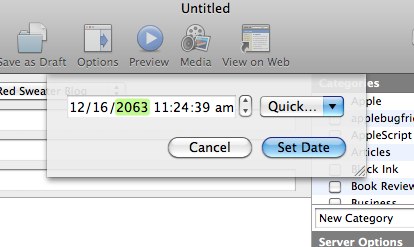Leopard Isn’t The Problem
April 12th, 2007Apple announced yesterday that Mac OS X 10.5, code/marketing-named “Leopard,” will not ship in Spring as promised, but will instead ship in October. (Confoundingly, the “Hot News” item at Apple doesn’t even have its own link, naked among the other public relations tidbits. Perhaps a sign that they’re not proud of the statement).
The announcement caps off a season of speculation alleging fluctuations in Leopard’s ship date. While early 2007 brought us lunatics predicting a March release, more recent speculation has hinted that a substantial delay was inevitable. This theory was soundly rejected by Apple less than three weeks ago, in a response to what turned out to be quite an accurate preview of the brutal truth.
The news has inspired reactions by respected Mac OS X developers (Gus Mueller, Brent Simmons, David Weiss, among others) and users (David Chartier, John Gruber, the Macalope, and many, many others). But while these people offer intelligent views on the relative pros and cons of the delay and its consequences to ordinary people, I don’t see much reaction to the core problems in Apple’s confession. I envision a bunch of PR folks sitting in an office toiling with the fact that they’ll have to break this unfortunate news. What to do, what to do. One of them has the brilliant idea that they can simply “blame” the iPhone. By blaming a problem on what’s widely perceived by the public to as a success, it will somehow make the company appear mature and well-reasoned in its decisions. Something more excusable than a company that occasionally fails to work a miracle. And somehow this idea made its way through some review process and all the way to public release. In stark contrast to Steve Jobs’s brilliantly candid Thoughts On Music, this statement sounds made-up and poorly thought-out. Bluntly crafted, sleazy marketing bullshit.
The best we can hope for is that it is only sleazy marketing bullshit. Because if what Apple’s telling us is true, then they’ve confessed something tragic: they’re incapable of building more than one amazing product at a time. The iPhone looks like it will be an amazing product, but if Apple can’t keep an OS team focused and operational at the same time as they keep a cell phone team hacking away, then the company is destined for extremely rough waters as it attempts to expand the scope of its product line.
What happens when the phone takes off, and Apple’s stuck following through on their Mac OS X commitments? “Sorry, no iPhone 2.0 until 2009 – we’ve had to move everybody back to OS X!” Needless to say, even with the apparent comingling of iPhone and iPod technologies, this situation leaves me unable to speculate as to when a dramatically new iPod might find time to be developed in this environment.
If Apple is truly so strapped for talent that they can’t focus on more than one product at once, then it’s a symptom of a sickness within the company. Perhaps they’ve regained success too quickly. If a company with a market capitalization of $80 Billion, and a cash account of at least $6 Billion, cannot hire enough people to build three of the hottest, most demanded products in consumer electronics (the iPod, the Mac, and the iPhone, if it’s not obvious), then maybe it’s time to reevaluate their modus operandi for attracting and retaining talent.
The first thing Apple should do is go global. Their products are universally renowned, yet the company requires the vast majority of its engineering teams to live and work in California – in a suburban, high-cost area of California, at that. Sure, Apple has a few small teams scattered around the world, but mostly as side-effects of specific acquisitions. The message to all Mac developers I know is being heard loud and clear: if you want to be part of this revolution, you’ll have to move to Cupertino. By limiting the company’s ranks primarily to those people willing to live in this one particular geographical location, they shut down their ability to attract a huge number of talented individuals.
If Apple’s having trouble growing its ranks of geniuses, the solution may require something that no amount of cash or stock can buy: a change of attitude.


